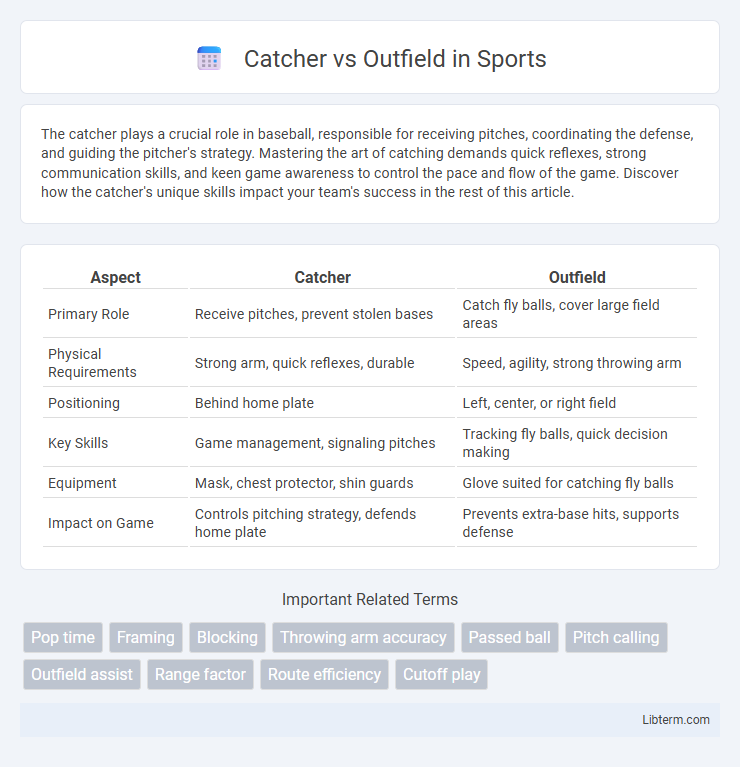The catcher plays a crucial role in baseball, responsible for receiving pitches, coordinating the defense, and guiding the pitcher's strategy. Mastering the art of catching demands quick reflexes, strong communication skills, and keen game awareness to control the pace and flow of the game. Discover how the catcher's unique skills impact your team's success in the rest of this article.
Table of Comparison
| Aspect | Catcher | Outfield |
|---|---|---|
| Primary Role | Receive pitches, prevent stolen bases | Catch fly balls, cover large field areas |
| Physical Requirements | Strong arm, quick reflexes, durable | Speed, agility, strong throwing arm |
| Positioning | Behind home plate | Left, center, or right field |
| Key Skills | Game management, signaling pitches | Tracking fly balls, quick decision making |
| Equipment | Mask, chest protector, shin guards | Glove suited for catching fly balls |
| Impact on Game | Controls pitching strategy, defends home plate | Prevents extra-base hits, supports defense |
Introduction: Understanding Catchers and Outfielders
Catchers are pivotal in controlling the game's pace by calling pitches and managing pitchers, positioned directly behind home plate. Outfielders cover extensive ground in left, center, and right fields, responsible for catching fly balls and preventing extra-base hits. Mastery of distinct skills like quick reflexes for catchers and speed plus arm strength for outfielders defines their specialized roles on the baseball field.
Key Roles and Responsibilities
Catchers serve as the defensive leader by calling pitches, managing the strike zone, and preventing stolen bases with precise throws. Outfielders play a crucial role in tracking fly balls, executing strong throws to bases or home plate, and backing up infielders to prevent extra bases. Both positions require keen situational awareness and quick reflexes to support overall team defense.
Physical Attributes and Skill Sets
Catchers require exceptional upper body strength and quick reflexes to handle fast pitches and make accurate throws to bases, while outfielders prioritize speed and agility to cover large areas of the field and track fly balls. Catchers must master skills like pitch framing, blocking, and game-calling, which demand strong hand-eye coordination and strategic thinking. Outfielders emphasize tracking fly balls, strong arm throws from deep positions, and rapid acceleration, crucial for preventing extra-base hits and supporting infield defense.
Equipment Differences Between Catcher and Outfield
Catcher equipment includes a helmet with a face mask, chest protector, leg guards, and a specialized catcher's mitt designed for catching fast pitches and providing maximum protection. Outfielders use lighter, larger gloves to increase catching range and flexibility, favoring mobility and quick ball transfers. Catcher gear prioritizes defense and impact absorption, while outfield equipment enhances agility and ball control at long distances.
Defensive Strategies: Behind the Plate vs. Outfield
Catchers employ defensive strategies centered on pitch framing, blocking wild pitches, and controlling the opposing team's running game by throwing out baserunners attempting steals. Outfielders prioritize tracking fly balls, maintaining optimal positioning to cut off extra-base hits, and executing strong, accurate throws to infielders to prevent runners from advancing. The catcher's role demands quick reflexes and game-calling acumen, while outfield defense relies on speed, communication, and territorial awareness.
Communication and Leadership on the Field
Catchers serve as on-field generals, directing infield and outfield players through constant vocal cues and hand signals, ensuring defensive alignment and pitch strategy execution. Their leadership fosters team cohesion by coordinating positioning and signaling potential plays, directly impacting defensive efficiency. Outfielders, while less involved in granular infield communication, provide critical backup by signaling ball trajectory and relaying information to infielders, contributing to overall field awareness and strategic adjustments.
Training and Drills Unique to Each Position
Catchers emphasize drills that develop quick reflexes and blocking skills, such as receiving multiple pitches in rapid succession and framing techniques to improve strike calls. Outfielders focus on footwork, sprinting, and tracking fly balls through drills that enhance their ability to judge distance and speed for efficient catches. Both positions incorporate throwing accuracy exercises, but catchers also practice snap throws to bases, while outfielders work on long-distance throws to infielders.
Notable Catchers vs. Legendary Outfielders
Notable catchers like Johnny Bench and Yogi Berra revolutionized the position with exceptional defensive skills and leadership behind the plate, setting standards for handling pitchers and controlling the game. Legendary outfielders such as Willie Mays and Hank Aaron combined speed, powerful batting, and remarkable fielding range, creating dynamic impacts on both offense and defense. The contrast between catchers' strategic command and outfielders' athletic versatility highlights the distinct contributions each position offers to baseball's rich history.
Career Longevity and Injury Risks
Catchers generally face higher injury risks due to frequent squatting, collisions at home plate, and repeated strain on knees and shoulders, leading to shorter average career longevity compared to outfielders. Outfielders benefit from less physical contact and lower-impact demands, contributing to longer careers and fewer chronic injuries. Statistical analysis shows catchers typically have careers lasting around 10-12 years, while outfielders often extend their careers beyond 15 years due to reduced injury prevalence.
Choosing the Right Position: Catcher or Outfielder?
Choosing the right baseball position depends on specific athletic skills and game strategy preferences. Catchers require strong defensive abilities, quick reflexes, and leadership to manage pitchers and control the game, while outfielders rely on speed, range, and strong throwing arms to track and catch fly balls effectively. Understanding personal strengths in agility, communication, and throwing accuracy can help determine whether the catcher or outfielder role maximizes a player's impact on the field.
Catcher Infographic

 libterm.com
libterm.com